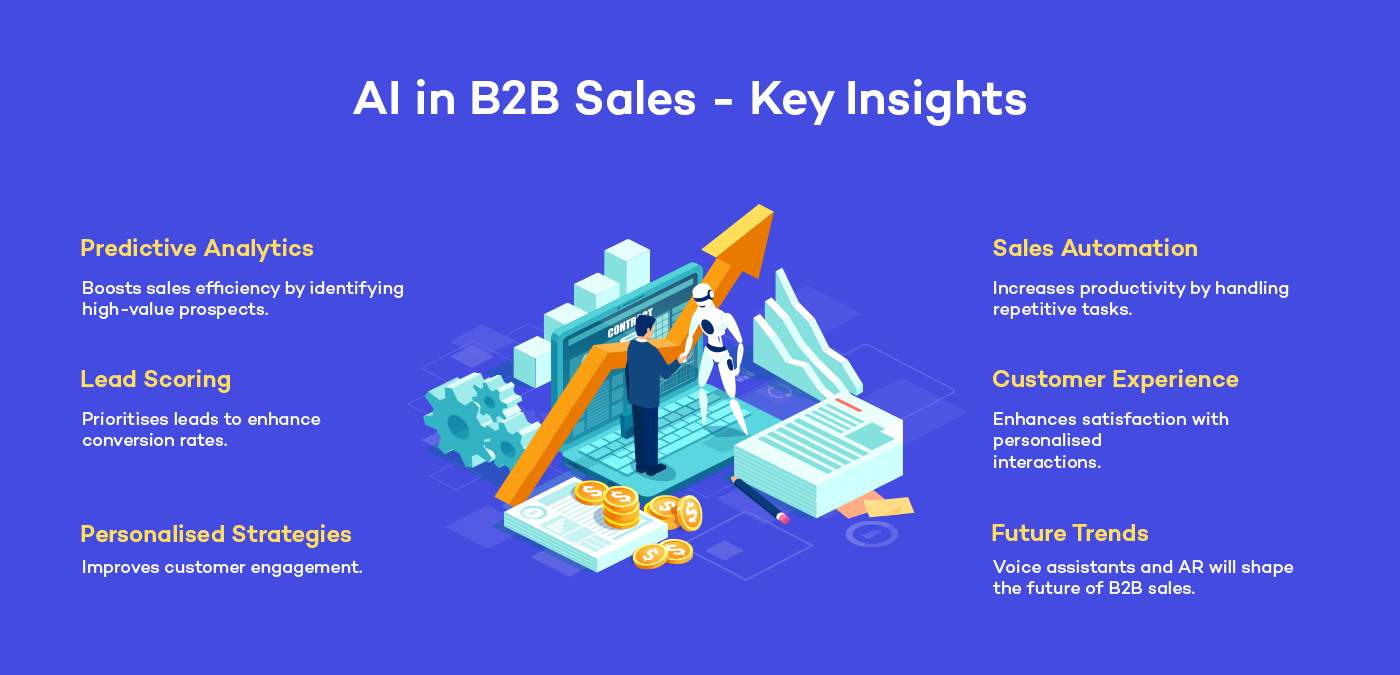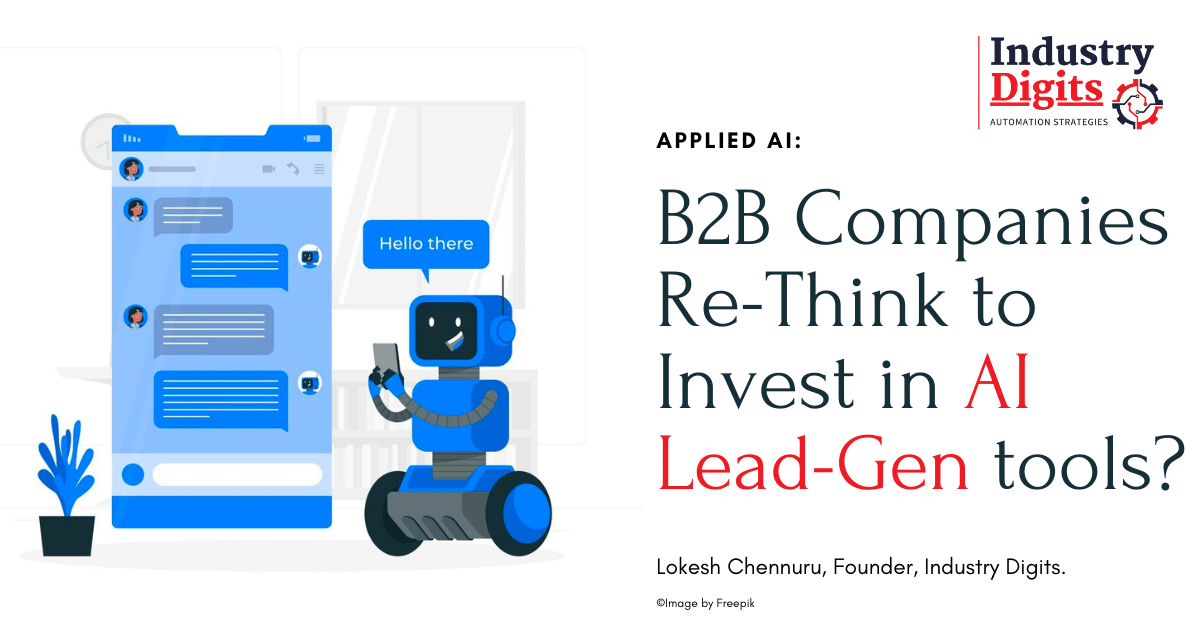The next wave of B2B operations with Growth Systems For B2B
AI Automation for B2B: Strategies to Improve Your Organization Efficiency
AI automation in the B2B market provides a pivotal possibility for companies to enhance their performance. By improving and enhancing procedures decision-making, organizations can achieve considerable performances. Nonetheless, the effective combination of AI requires mindful consideration of various factors. Comprehending which locations to automate and choosing proper devices are simply the beginning. The potential for makeover raises essential concerns regarding execution and ongoing assessment. What methods will ensure long-term success in this advancing landscape?
Recognizing AI Automation in B2B Context
As businesses increasingly look for efficiency and innovation, recognizing AI automation in the B2B context ends up being crucial. AI automation leverages sophisticated technologies to simplify processes, improve decision-making, and boost overall performance. By incorporating AI devices, firms can maximize operations such as supply chain monitoring, consumer partnership management, and data analysis. These modern technologies can evaluate vast amounts of data quickly, offering workable insights that drive tactical efforts. In addition, AI-driven automation reduces human mistake and maximizes staff members to concentrate on even more complex jobs. By promoting partnership in between human intelligence and machine abilities, organizations can achieve an one-upmanship. Inevitably, comprehending AI automation is vital for B2B companies intending to grow in a significantly electronic industry.
Determining Locations for Automation
In the pursuit for reliable AI automation in B2B, it is vital to determine details areas where automation can yield considerable advantages. This includes reviewing task repetitiveness, checking out possibilities for information handling, and determining process traffic jams. By concentrating on these elements, organizations can simplify procedures and enhance productivity.
Job Monotone Analysis
Task repetitiveness analysis plays a necessary function in determining locations ripe for automation within B2B procedures. Minarik AI. This procedure includes examining day-to-day tasks to figure out which are recurring and taxing, thus preventing performance (Growth Systems For B2B). By inspecting process, companies can determine particular functions that call for extreme manual input, such as information access, billing processing, or client follow-ups. Recognizing these repeated tasks allows companies to allot resources a lot more effectively, boosting total efficiency. In addition, automation can lessen human mistake, improve procedures, and maximize employees to focus on higher-value activities. Performing a complete job monotone assessment equips B2B organizations to take on targeted automation strategies, inevitably driving improved efficiency and affordable benefit in the industry
Data Handling Opportunities

Workflow Bottleneck Identification
Recognizing workflow bottlenecks is a crucial step in recognizing the complete benefits of automation within B2B companies. These traffic jams frequently manifest as delays, source constraints, or ineffective processes that prevent performance. To efficiently pinpoint these areas, companies can conduct complete analyses of their process, using metrics such as cycle time and throughput. Involving workers in discussions about discomfort points can also supply valuable insights. Organizations can prioritize them based on influence and feasibility for automation when bottlenecks are determined. By tactically addressing these inefficiencies, B2B companies can improve operations, improve cooperation, and inevitably boost total efficiency. This aggressive technique to process evaluation lays the groundwork for successful automation initiatives that drive business development.
Choosing the Right AI Equipment and Technologies
As companies increasingly transform to AI to improve their operations, picking the right tools and modern technologies becomes necessary for achieving preferred end results. Organizations has to assess their certain demands and objectives, thinking about variables such as user-friendliness, scalability, and compatibility. An extensive market evaluation can aid recognize leading AI solutions tailored for their industry. Additionally, companies must examine the technical framework called for to sustain these devices, making certain smooth assimilation with existing systems. Information protection and conformity with laws are additionally essential factors to consider that affect device option. By concentrating on these requirements, business can make educated decisions that drive efficiency and productivity, inevitably bring about boosted organization efficiency. The best AI tools empower companies to introduce and preserve a competitive side in the marketplace.
Developing a Calculated Application Strategy
A successful tactical implementation prepare for AI automation in B2B calls for clearly defined vital purposes. Furthermore, organizations have to examine their current capabilities to recognize voids and chances for improvement. Continual surveillance and modification of the strategy will certainly guarantee placement with progressing company demands and innovation advancements.
Specify Key Purposes
To guarantee effective AI automation in B2B atmospheres, specifying essential purposes is necessary for developing a critical application strategy. Organizations should recognize particular, quantifiable goals that line up with their total company approach. This clearness gives a roadmap for the automation process, making sure that initiatives are focused on locations that will produce the highest effect. Trick objectives may consist of improving operational performance, boosting customer fulfillment, or increasing income. Establishing these purposes enables teams to focus on sources effectively and track development gradually. Additionally, clear goals facilitate far better communication amongst stakeholders, fostering partnership and placement throughout the company. Ultimately, well-defined goals serve as the structure for a durable AI automation strategy that drives business efficiency.
Analyze Existing Capabilities
Before carrying out AI automation, companies must thoroughly examine their current capacities to identify weak points and strengths. This evaluation involves taking a look at existing technologies, labor force abilities, and functional processes. By carrying out an in-depth audit, organizations can determine locations that require enhancement or financial investment. Organizations should also consider their data management practices, as the quality and access of data are essential for successful AI combination. Recognizing the current technological landscape enables companies to align their resources and capabilities with their tactical goals. Additionally, it is important to review company society and readiness for change, as these elements greatly influence the fostering of AI solutions. This assessment functions as the structure for creating a strategic application strategy that takes full advantage of the possibility of AI automation.
Display and Change
Applying AI automation calls for a vibrant technique that highlights constant monitoring and change. Companies should create a strategic application strategy that includes regular assessments of AI efficiency versus predefined metrics. This includes monitoring vital performance signs (KPIs) to evaluate the effectiveness of automation remedies. By examining data, companies can determine locations for enhancement and adjust their AI systems appropriately. Engaging with stakeholders throughout the process ensures that the automation lines up with organization goals and individual requirements. Furthermore, promoting a culture of flexibility enables companies to react swiftly to altering market conditions and technical innovations. Growth Systems For B2B. Eventually, recurring tracking and modification not just enhance functional efficiency however also drive continual service efficiency in the affordable B2B landscape
Ensuring Data Top Quality and Integration
As companies significantly depend on AI automation in B2B procedures, making sure data high quality and integration comes to be crucial for success. High-quality information is crucial for accurate analytics, notified decision-making, and effective client involvement. Data must be cleaned up, standardized, and validated to eliminate mistakes and variances that might cause misdirected understandings. In addition, smooth combination throughout different platforms and systems is important; disparate information silos prevent automation initiatives and lower functional performance. Organizations should adopt robust information administration structures and utilize sophisticated tools to facilitate information assimilation while keeping top quality criteria. By prioritizing these components, companies can improve their AI automation efforts, ultimately bring about boosted efficiency and an affordable advantage in the B2B landscape.
Gauging Success and ROI of AI Initiatives
Just how can organizations effectively gauge the success and roi (ROI) of their AI campaigns? To assess performance, services should develop clear, quantifiable objectives lined up with strategic objectives. Key efficiency indications (KPIs) such as price savings, earnings development, and performance enhancements can give valuable understandings. Organizations commonly conduct baseline analyses prior to carrying out AI, enabling them to contrast pre- and post-implementation metrics. In addition, analyzing client satisfaction and interaction can expose the effect of AI on customer experience. Routinely examining these metrics helps in refining AI approaches and making sure placement with company objectives. By using a structured technique to dimension and evaluation, organizations can properly analyze the effectiveness of their AI efforts and make educated choices about future investments.
Getting Rid Of Obstacles in AI Fostering
Although numerous organizations identify the possibility of AI to change their operations, they frequently come across substantial challenges during adoption. Trick hurdles include a lack of knowledgeable personnel, which hinders the reliable execution and management of AI innovations. Organizations likewise encounter assimilation issues, as existing systems may not be compatible with brand-new AI remedies. In addition, concerns regarding data privacy and safety and security can cause resistance in totally welcoming AI capabilities. Resistance to change from employees can even more complicate the shift, necessitating extensive training and communication methods. To get rid of these difficulties, companies must purchase skill development, assurance robust information administration, and promote a culture that embraces advancement, inevitably leading the way for effective AI combination and improved company performance
Frequently Asked Inquiries
Just How Can AI Automation Improve Client Relationship Monitoring in B2B?
AI automation can improve customer partnership administration in B2B by streamlining interaction, offering personalized communications, evaluating consumer data for understandings, automating follow-ups, and enhancing response times, eventually fostering more powerful relationships and driving sales development.
What Industries Benefit The Majority Of From AI Automation in B2B?
Manufacturing, money, healthcare, and logistics sectors benefit most from AI automation in B2B. These markets leverage automation to enhance processes, improve information analysis, boost customer communications, and eventually increase functional performance and success.
Just How Does AI Automation Impact Worker Responsibility in B2B Companies?
AI automation changes staff member functions in B2B business by streamlining tasks, minimizing repetitive work, and making it possible for staff to focus on calculated campaigns. This shift improves performance and cultivates a culture of development and flexibility.
What Are the Prices Connected With Carrying Out AI Automation?
The prices connected with implementing AI automation include initial software acquisition, framework upgrades, training costs, recurring upkeep, and possible integration challenges. Business Process Automation. Companies need to additionally consider long-lasting functional changes and employee adaptation expenses in their monetary preparation
Just How Can Companies Make Sure Moral AI Usage in Their Operations?
Companies can ensure moral AI usage by developing clear guidelines, promoting transparency, conducting routine audits, including varied stakeholders, and focusing on information personal privacy. Continual training and awareness programs even more enhance understanding and adherence to ethical methods.
